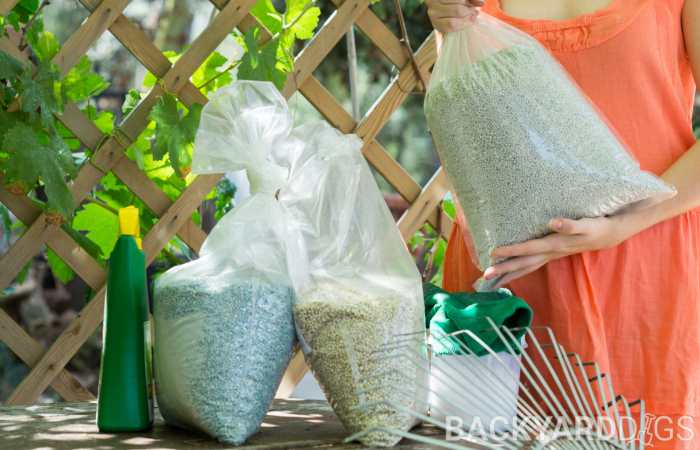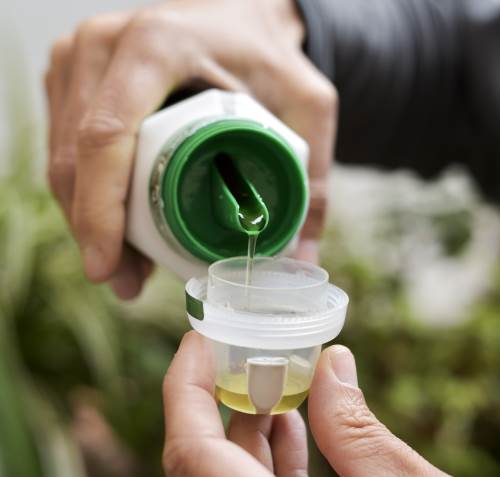Houseplant and garden fertilizer is a must-have product when you want healthy plants.
Many people have old fertilizer they’re unsure is safe to use. Should you toss it out, or can your plants still benefit from its ingredients?

Does fertilizer go bad? Not if you store it correctly.
Stick around to learn about:
- Fertilizer shelf life
- How long fertilizer lasts in soil
- If plant food expires
- Signs liquid or dry fertilizer is bad
- Steps to store fertilizer
Fertilizer is a crucial tool for vibrant plants, so let’s learn how to handle it properly!
How Long Does Fertilizer Last?
The shelf life of all types of fertilizer is a mystery for most gardeners since expiration dates are rarely on the packaging.
The following list can help you gain a better understanding of fertilizer shelf life under proper storage conditions.
- Liquid mineral fertilizer: Up to 10 years
- Liquid organic fertilizer: 5-8 years
- Weed and feed fertilizer: 4 years
- Dry granular fertilizer: Lasts indefinitely
- Dry crystallized fertilizer: Lasts indefinitely
- Microbial Inoculants: 2 years
Liquid mineral fertilizers, such as Ocean Magic, stay viable for up to a decade, but you need to shake up the bottle before each use since the minerals settle to the bottom during storage.
Liquid organic fertilizers, typically made from seaweed, should last about five years before the ingredients go rancid. These fertilizers have a powerful, offensive odor when fresh, so it may be challenging to determine when it goes bad.
Related | Is Milk Good For Plants?
Herbicides in weed and feed fertilizers, such as Miracle-Gro Shake n Feed, break down the components over time, which is why they have a shorter shelf-life than other types of fertilizer.
Dry granular fertilizer is very common for lawn applications. Brands like Scott’s Turf Builder retain their active ingredients until you place them on the soil for plants to use up.
Dry crystallized fertilizer, like Miracle-Gro All-Purpose Plant Food, is made to dissolve in water so you can apply it to your plants. The nutrients stay intact within the crystals indefinitely as long as it doesn’t get wet.
As a general rule, never store fertilizers that contain herbicides or pesticides, which degrade the ingredients quickly. Use them up each year, or give them to someone who will.
How Long Does Fertilizer Last In Soil?
The fertilizer type you use will determine how long it will remain in the soil.
Soil conditions and the number of plants in the area also play a role in how fast nutrients from the fertilizer deplete in the ground.
This is how long you can expect fertilizer to last in soil:
- Liquid fertilizer (organic): 2-4 weeks
- Dry fertilizer (organic): 4-6 weeks
- Liquid fertilizer (synthetic): 1-2 weeks
- Dry fertilizer (synthetic): 4-36 weeks
Organic fertilizers require extra time to break down into the minerals and micronutrients plant roots can take up.
Synthetic liquid fertilizers have nutrients that are “ready for uptake,” so they typically won’t last in the soil for more than a week.
Granule synthetic fertilizers typically have a coating or binder around the active ingredients to slow down the rate the nutrients soak into the ground, so they last much longer.
Related | Does Potting Soil Go Bad?
Does Plant Food Expire?
Some plant food, especially organic fish blends, does expire because the natural ingredients degrade over time.
Synthetic liquid or granular plant food will not expire if you store it under perfect conditions.
If synthetic crystals or granules get wet from rain, snow, ice, a sprinkler, or even high humidity, the material will quickly absorb the moisture and start breaking down.
If such material remains inside a plastic bag or container, you can still use the product, but if it’s left in a box or sack that leaks, the nutrients will leach out.
How To Tell If Fertilizer Is Bad
Here are the five signs your fertilizer may be bad:
- 1. Change of texture or a bulging bottle
- 2. Odd smell
- 3. Change of color
- 4. Infested with bugs
- 5. Mold growth
Not all of the signs above mean you must throw away the fertilizer. In many cases, the ingredients are still active, but you’ll have to do a bit of work to fix it so you can spread it on your plants.
Related | How To Dispose Of Fertilizer
How To Tell Liquid Fertilizer Is Bad
Synthetic liquid fertilizer rarely goes bad before you use it all.
Liquid fertilizers that use organic ingredients do go bad as no stabilizing chemicals, aside from natural phosphoric acid, are used to keep it from degrading.

After opening the container, organic fertilizer has no means to control how long the active ingredients will remain dormant.
Once the liquid’s biological components become active, fungi and bacterial growth will occur in the container.
You may actively see mold growth, or witness the bottle bulging out from the production off-gasses as the mold feeds. The liquid will also take on a strange consistency and rancid odor.
When you witness any of these indicators, please don’t put the product on your plants, as it may cause harm.
How To Tell Granular Fertilizer Is Bad
Hardening or “melting” of granular fertilizer can happen under moist conditions, but you can still dry and break up this material and use it safely on your plants.
Organic granular fertilizers are very attractive to many insects and animals, especially cats, mice, rats, and beetles. These critters may leave behind feces or bacteria that could be harmful to plants, so don’t use them if you see waste products in the fertilizer.
Small quantities of mold growth on granular fertilizer should not cause issues for plants. Use the material as usual, or spread the material in a dry location for a few days to kill off the fungi before putting it around plants.
Microbial Inoculants
Microbial inoculant fertilizers are very sensitive to environmental conditions, especially temperatures below 60 degrees or above 80 degrees Fahrenheit.
Microbial inoculants are a specialized fertilizer that includes nutrients and microbes.
The fertilizer contains living spores of beneficial fungi species and good bacteria that aid in the soil’s nutrient breakdown. More nutrients in the ground that a plant’s roots can readily absorb means an increase in growth and health.
Once you open the seal on the bottle, warm air can activate the spores or bacteria, which will feed on the nutrients inside the bottle, so nothing remains for your plants.
Setting the bottle in a hot location or direct sunlight will cook the bacteria and fungi, causing them to die. Once this happens to a bottle of microbial inoculants, it will reduce or completely ruin the fertilizer’s effectiveness.
You can safely pour the defective liquid into your garden, but don’t expect to see any noticeable positive results.
How To Store Fertilizer
Step 1 – Gather Suitable Containers
Most packaging for dry or crystallized fertilizer will be ineffective in protecting the product during long-term storage.
Use ziptop baggies or airtight containers large enough to hold the fertilizer.
There is no need to move the product into a different bottle for liquid fertilizers unless the original has cracks.
Have a permanent pen or marker on hand to label each bag or container with name brand and type of fertilizer, along with the original purchase date so that you can track the age of the product.
Step 2 – Seal Up The Fertilizers
For liquid fertilizers in a sturdy bottle, you’ll only need to wipe down the spout and neck area with a rag, then screw on the cap lightly.
Always store the fertilizer bottles in an upright position and add the purchase date with a marker if there’s no expiration date on the label.
For granular fertilizer, pour dry material from opened bags into your container of choice. Remove as much air as you can and seal the container.
WARNING: Never mix different fertilizers in a single container as a dangerous chemical reaction can occur.
Step 3 – Store The Fertilizer In A Safe Space
The best place to store fertilizer is in a dry location away from sunlight and exposure to extreme temperature swings.
A temperature and humidity-controlled garage, greenhouse, basement, or shed is best. Avoid leaving fertilizer in storage bins outdoors or sheds with no protection from heat, cold, or pests.
- Liquid fertilizer can freeze, which can alter its effectiveness once it thaws back out.
- Keep the fertilizer well-marked and out of reach of pets or kids.
- Do not store the fertilizer near paints, chemicals, or pesticides.
In Summary
Fertilizer is worth the investment, but storing it often leaves many homeowners confused on the best way to keep it in good condition.
I hope this article helped clarify how to tell when fertilizer is bad. I also hope you use the tips to store fertilizer correctly, so you can use it safely for many gardening seasons to come!











